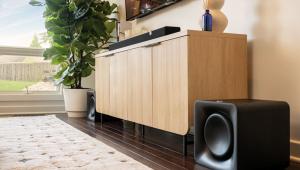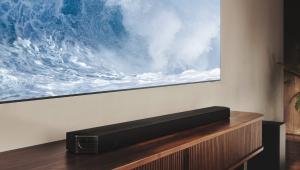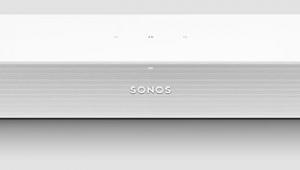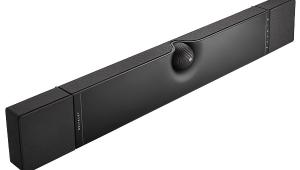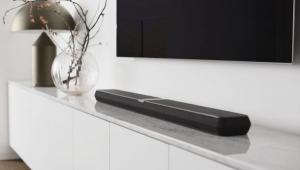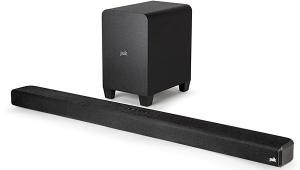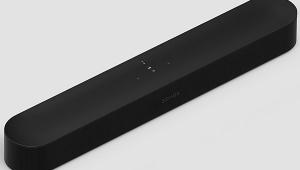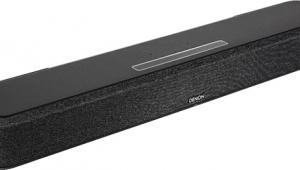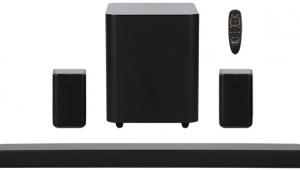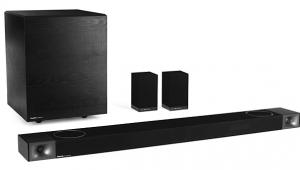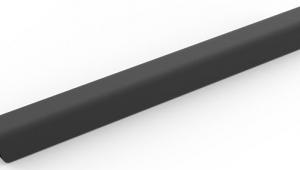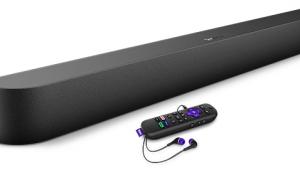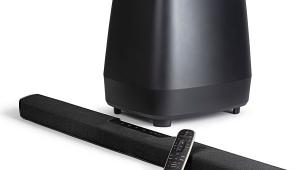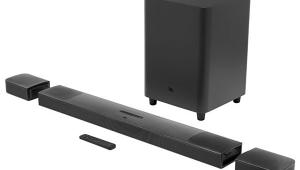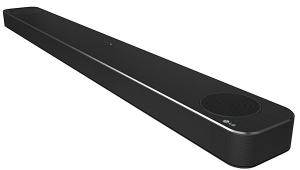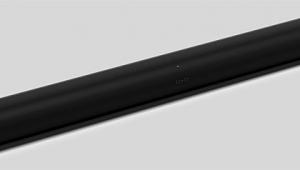Soundbars on a Budget Zvox SB500

Zvox SB500
PRICE $500
AT A GLANCE
Plus
Powerful, dynamic bass in a standalone bar
Impressive soundstage spread
Rock-solid build quality
Minus
No HDMI
Spatial processing always on by default
THE VERDICT
Startling, impactful bass and a big, spacious presentation make this badass Zvox soundbar a winner.
Zvox was an early purveyor of the soundbase, or rather, SoundBase, to respectfully recognize the company trademark they created before anyone else began using that phrase to generically define the category. Only recently have they introduced traditional soundbars, but with the same commitment to creating standalone theater systems that deliver uncommonly prodigious bass without a separate subwoofer.
The SB500, recently reduced from $600 to $500, is the middle soundbar between Zvox’s SB400 and new SB700; it’s recommended for TVs 50 to 90 inches. The brushed black aluminum cabinet measures 43.9 inches wide by 5.7 inches tall, or you can lay it on its back and it’ll stick up just 3.2 inches. There are separate EQ settings for wall mounting or either tabletop position. At 12.6 pounds, it feels and looks substantial next to the toy-like demeanor of most soundbars. There’s an alphanumerical display on the right that becomes momentarily visible behind the metal grille when adjustments are made to volume, input, or the listening mode. Manual controls for power, volume, and input are on the bar’s right side.
 Inside the bar are three forward-firing 2-inch full-range drivers placed left, center, and right, and a pair of 4-inch long-throw woofers. DSP-controlled Class D amplifiers provide 140 watts of power in total and allow the bass to push cleanly down to a claimed 42 Hz (with no –3 dB point specified). In my room, bass sweeps revealed substantial output below 50 Hz and still noticeable bass at 40 Hz before it dropped off. None of the other tested bars came close. There are no HDMI inputs, but you get one each digital (a shared optical or coax), analog RCA, and Bluetooth (aptX). The credit-card remote is a bit larger than a playing card and uses membrane buttons.
Inside the bar are three forward-firing 2-inch full-range drivers placed left, center, and right, and a pair of 4-inch long-throw woofers. DSP-controlled Class D amplifiers provide 140 watts of power in total and allow the bass to push cleanly down to a claimed 42 Hz (with no –3 dB point specified). In my room, bass sweeps revealed substantial output below 50 Hz and still noticeable bass at 40 Hz before it dropped off. None of the other tested bars came close. There are no HDMI inputs, but you get one each digital (a shared optical or coax), analog RCA, and Bluetooth (aptX). The credit-card remote is a bit larger than a playing card and uses membrane buttons.
The bar has IR learning to operate volume and mute from your settop box or TV remote, though you’ll probably also want access to the supplied remote, which offers bass/treble adjustments and can activate Zvox’s Accuvoice dialogue booster and Output Leveling dynamic compression feature for late-night listening.
More critical is the surround button that cycles through three levels of the company’s long-established PhaseCue surround processing, which is said to manipulate phase information in the signal to spread the sound and create a soundstage far beyond the edges of the product. By default, the bar is always in one of these three modes; there’s no way to defeat it fully. Experimenting with the settings on different material revealed not-so-subtle differences. Sd1 applies the least amount of processing, providing the most etched vocals while still delivering a rather large soundstage that went easily beyond the ends of the bar and was both tall and noticeably deep. Sd2 tamed the vocals a bit and expanded the front image in all dimensions. Sd3 took the staging out another big notch in all directions; depending on the content, it had the effect of making some elements originate from the side walls and pushed the vocals deeper back
in the mix, sometimes making them harder to discern. The Accuvoice button disables the PhaseCue processing and pulls vocals up even beyond what I heard on the Sd1 mode. I found it edgy, but I’m guessing those with compromised hearing will hear appropriate compensation rather than being bothered by it.
Music
It only took a few seconds of my very first track on the Zvox—John Mayer’s “Gravity”—to recognize the value of its deep, powerful bass. The kick drums had real visceral impact and drumlike timbre that was missing from all the other bars; I could hear the decay of the drumhead that followed the strikes. In Sd1 surround mode, the vocal was detailed and clear, if perhaps a touch hot—something that eventually became grating over time in this mode. Fortunately, that was largely mitigated by switching to Sd2 or Sd3 and/or riding the treble down a notch or two, though you’d always characterize the overall voicing here as more etched and sparkly than warm.
Along with the deep bass, and the clear and present mids and highs, the PhaseCue processing really helped bring things to life. On “Hey Jude,” off The Beatles’ Love, the tambourine and bells were nicely delineated in space, and McCartney’s tight-up lead vocal had that you-are-there immediacy.

The Sd3 processing I used on this track really filled the room, taking the incoming strings and horns out to the side walls. It all sounded big, loud, and well controlled—and with the volume set to 18 or 19 out of 30, the SB500 wasn’t even breaking a sweat. I measured 92 dB max at my listening seat on the steady-state pink noise, but it wasn’t just the overall level the Zvox delivered, it was the authority it asserted. The word “dynamic” appears again and again in my notes.
Movies
Lacking separate rear speakers, there was no way the SB500 could deliver the surround effects in Hugo or Mad Max with anything close to the spatial accuracy the Vizio SB3851 or my discrete reference system could. But the PhaseCue processing, especially on the Sd3 mode, really put the room into play for the Zvox and was far more effective than anything the Yamaha or Acoustic Energy could do. The monologue and surrounding effects at the beginning of Max didn’t come from directly overhead or behind as they should have, but they did come off the screen and situate high up toward the middle-front of the room. And the low-frequency energy of the engine rumble in this soundtrack was not only more viscerally present thanks to the deeper bass output, but seemed to come from
the side walls as well as the front. Similarly, the swirling sketches in Hugo still managed a circle despite the lack of surrounds, moving inside a truncated dome above and in front of me. The reverberant acoustic of the train station was also well rendered; music playing softly over the PA in the background appropriately seemed to come from everywhere. Whether true to the mix or not, the processing was impressively engaging.
Conclusion
Zvox’s SB500 proved itself an extremely able music reproducer but an even better movie machine capable of surprisingly powerful, deep bass and dynamic headroom that I’ve simply never heard before in any onepiece soundbar. It’s a remarkable standalone solution and, given the performance of the integrated subwoofer system and the superb build quality, an excellent value.
- Log in or register to post comments

